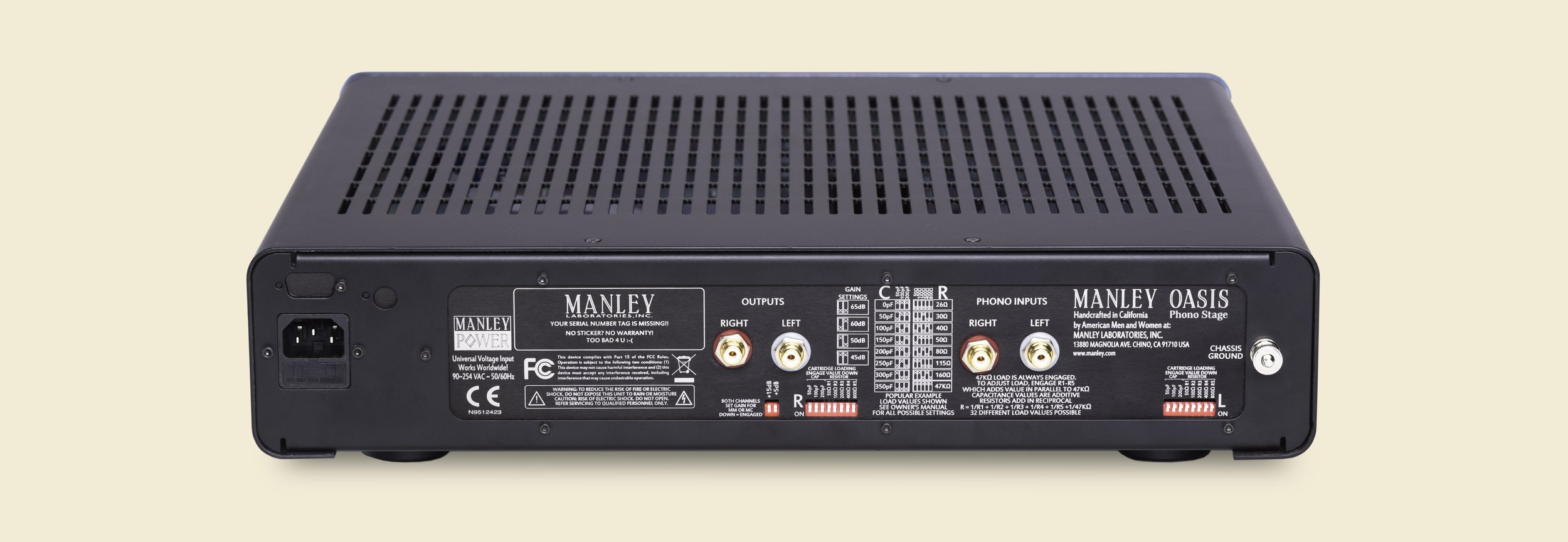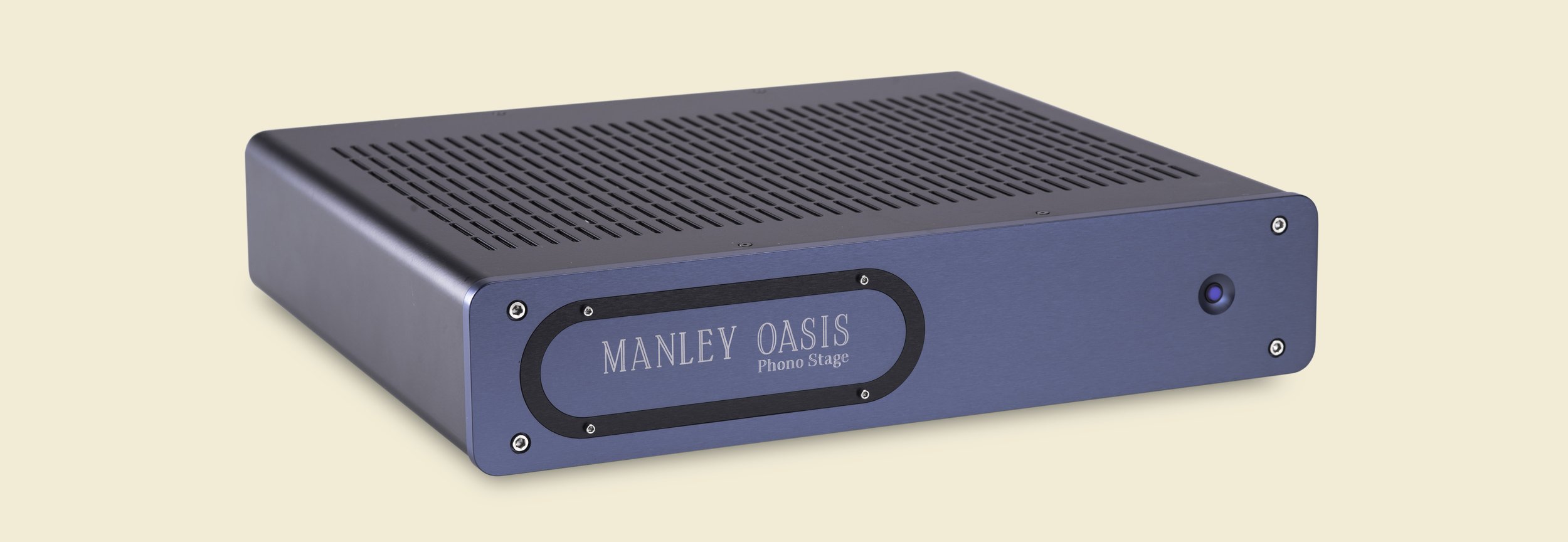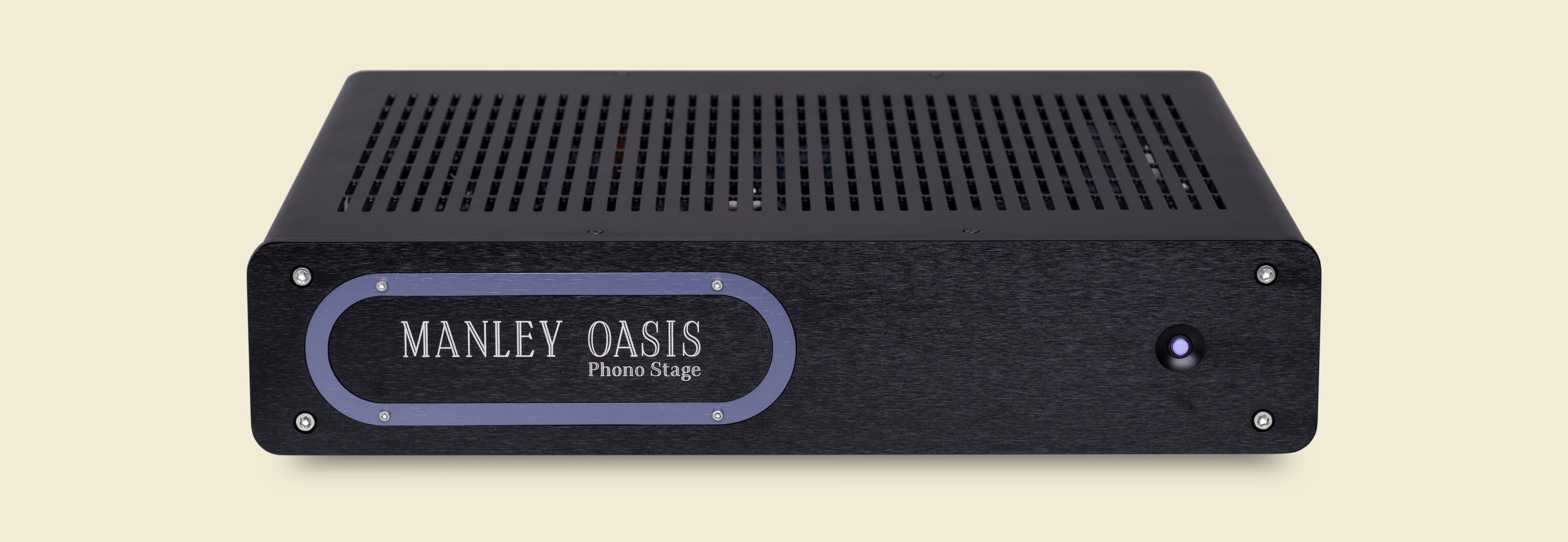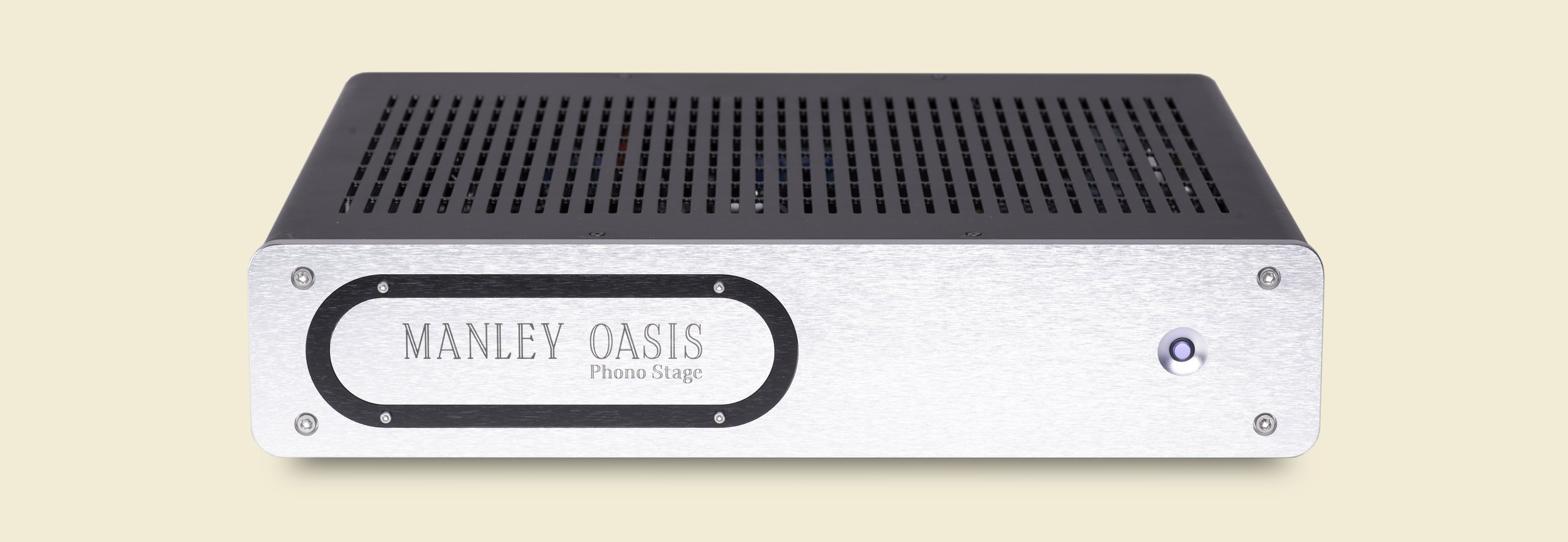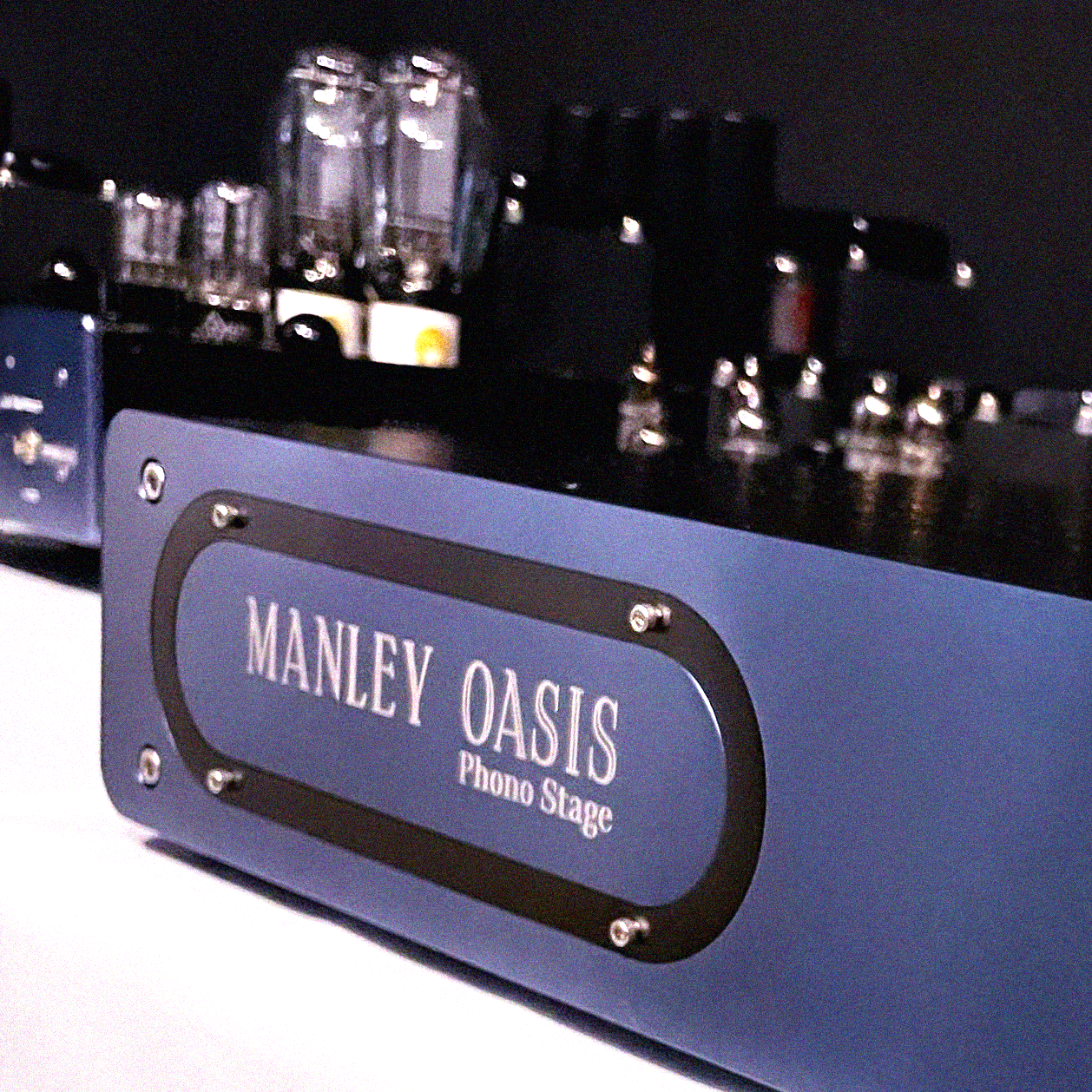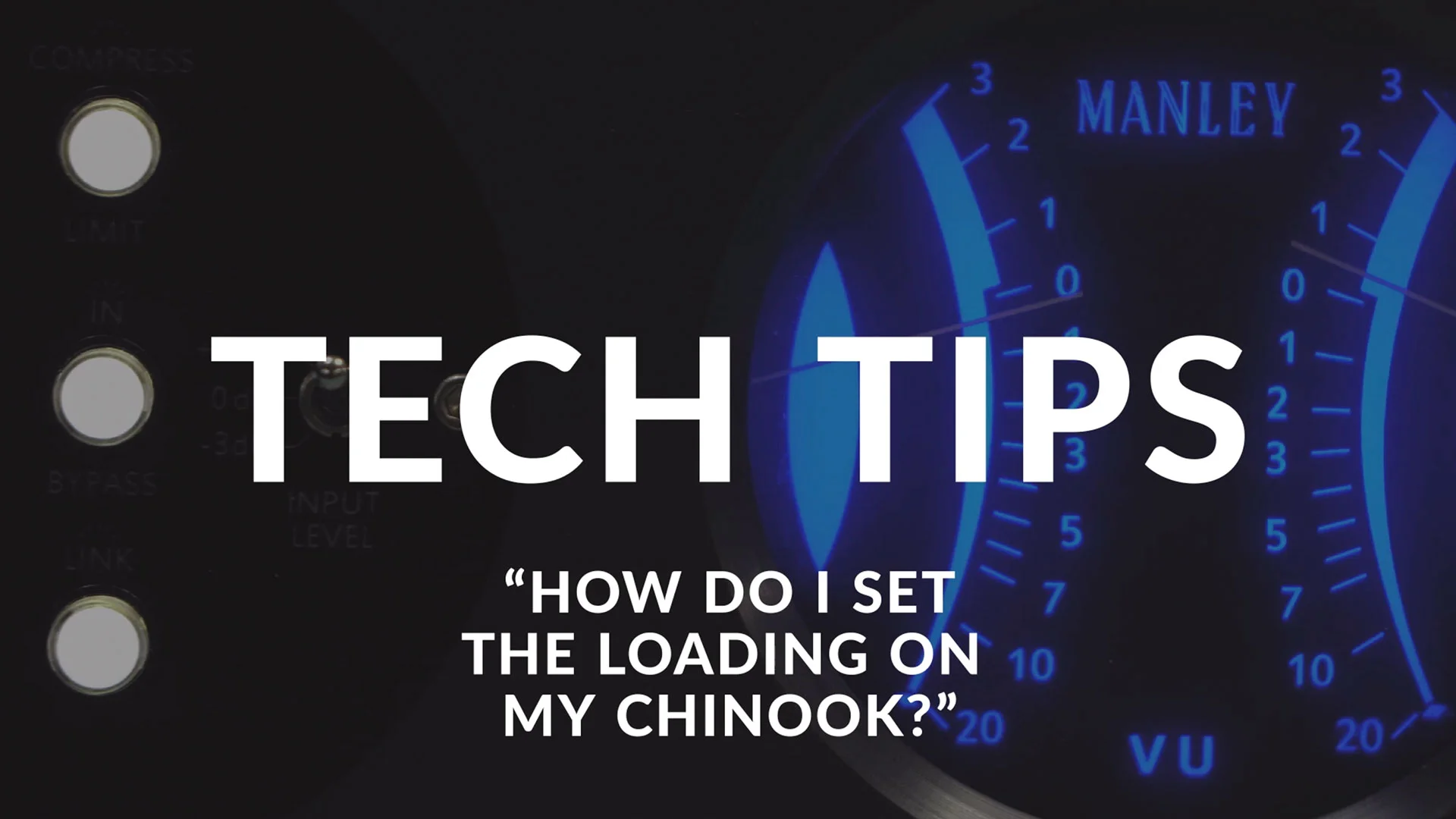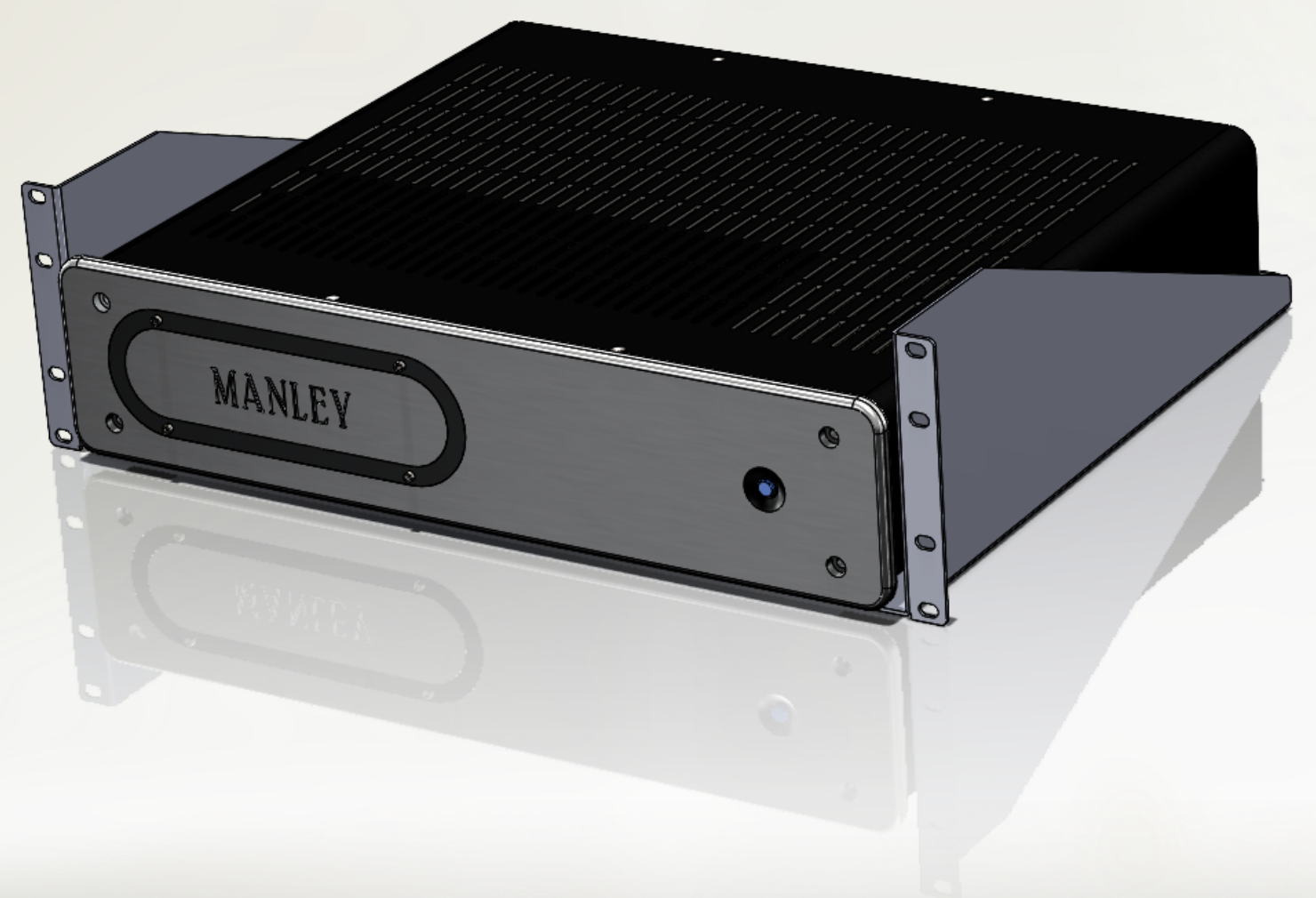
Brand new for 2024, The Manley OASIS Phono Stage replaces the CHINOOK
At last, our favorite phono stage has been updated to operate with MANLEY POWER® which provides an even quieter blacker black background, yielding quicker sonic extremes over our older linear PSU designs. President EveAnna Manley recalls the moment she first made the comparison, “I brought a regular CHINOOK with its linear power supply, a stock unit, to Los Angeles to listen to it against a second CHINOOK that had been modified to work with our new MANLEY POWER® switch mode power supply. My buddy Pete Lyman at Infrasonic Mastering spun up some vinyl records that he had cut the masters for on his lathe. Using his mastering studio environment, we were able to conduct a very precise comparative listening test between the two units. And even though we could not see which unit we were listening to, the sonic differences were unmistakable, and we both heard the same superiority in the new power supply design. I still can’t believe what a stunning technical and sonic accomplishment MANLEY POWER represents, and delivers as we adopt more of our designs to take advantage of our proprietary system.”
The OASIS Phono Stage offers an improvement in convenience over the older CHINOOK as the GAIN selections have been brought out from inside the chassis to the rear panel for easier access residing next to the resistive and capacitive loading DIP switches. There are tons of loading options to mate with any Moving Coil or Moving Magnet cartridge. Once you have set your GAIN and Loading for your cartridge, you’re done! Set it and forget it!
The OASIS sports an upgraded more luxurious chassis design while its efficient internal build keeps the price affordable. And like all Manley products, each OASIS Phono Stage is loyally handcrafted in the USA by American men and women at our Southern Californian factory located just 35 miles east of Los Angeles.
DRIVEN BY MANLEY POWER®
DRIVEN BY MANLEY POWER®

DETAILS
The logical successor to the legacy Chinook, our new OASIS Phono Stage deploys our modern dedicated power supply and construction to usher a new series of Manley preamplifier designs to your home. Named after one of our dearest Mastering Studio partners, the OASIS carries forth the clean and precise audio circuits of the prior Steelhead and Chinook audio paths into a new age of high fidelity preampfification offerings from Manley Labs.
Like the Steelhead, each channel employs the two triode sections of a 6922 for amplifying duties assisted by low noise FETs receiving the signal below each cathode. Highly accurate passive RIAA equalization networks perform the decoding task to restore the originally intended frequency response to the audio signal. In the Oasis, the signal passes through no Integrated Circuits. There are ICs deployed in a servo configuration to apply a precise biasing voltage to the Gate of each FET, and you might notice some other chips who are performing some LOGIC functions to direct the turn on and shut down sequences invoking the MUTE relays to prevent unwanted bumps or noises when the unit is power cycling. Importantly, the signal is directly coupled from the gain stages to another 6922 dual triode serving as the output driver in a White Follower configuration. This output stage circuit is our favorite because of its super-low output impedance and beefy current-driving capabilities. It can drive long cable lengths and difficult loads, tube or solid-state. Bring it on. No wimpy cathode followers here!
The chassis is a new powder-coated over zinc passivated steel design which will be shared amongst 3 other upcoming new Manley preamplifiers. Through this efficiency we have splurged a bit and created a more luxurious housing with its large-radiused substantial top cover sporting smooth rounded side edges. Rounding out the casework, the frontal face is adorned by a 3/8” thick CNC milled facia with an intricately inlaid contrasting “racetrack” insert for visual interest. The OASIS moniker is laser-engraved into the oblong island on the façade. By popular request we have made the faceplates available in traditional “Manley Blue” aka “Pewter Grey”, Silver, or Black. Click on the main photo above to explore the color combinations.
Setting up the Oasis is easy and requires no entry into the interior of the unit. On the rear panel you will find all the switches that you need to optimize your cartridge interface to the Oasis. Depending on the nominal output level of your cartridge, GAIN can be set to 45dB, 50dB, 60dB or 65dB of amplification. These GAIN choices will accommodate all Moving-Magnet and Moving-Coil cartridges. The back panel also contains DIP switches for adjusting the input resistive and capacitance loading values. 31 possible options between 26 and 800 Ohms plus 47k Ohms and 7 capacitive loading choices between 50 pF and 350 pF provide flexibility to match any cartridge and fine tune the tone. Set it and forget it! Audiophile-grade and time-proven componentry is used throughout, embodying Manley's dedication to seductive sonics, combined with the reliability that professionals around the world depend on. At just about a quarter of the price of our revered Steelhead preamplifier, the Oasis maintains focus on elegance of design, careful execution, efficient construction, and appreciable quality.
Designed and built in California, the Oasis exemplifies Manley's commitment to our local community and to a simple, clean, and quiet signal path. The Oasis demonstrates the supreme linearity of vacuum tubes while providing the flexibility needed to embrace any turntable setup. Everything from the most exotic 180 gram audiophile pressing to 25 cent thrift-store classics will be reproduced accurately and musically.
Stop worrying about the settings! Find solace in our OASIS, sit back and enjoy your records!
SPECIFICATIONS
Vacuum Tube Complement: 6922 x 2 (gain stage) plus 6922 x2 (output stage). Any 6DJ8, 7308, ECC88 types may be used.
Unbalanced Input and Output connections via Manley Teflon ® & Gold plated RCA jacks
Automatic Mute Timer: On initial power up output jacks are muted for approximately 45 seconds. Automatic mute circuit allows tubes to warm up and circuitry to settle. At power down, output jacks are immediately muted.
Input Termination Capacitance: 3-position user-selectable capacitor values of 50pF, 100pF, and 200pF yield resultant combinations of: 50, 100, 150, 200, 250, 300, and 350pF. Use these settings typically for Moving Magnet (MM) cartridges.
Default Input Impedance: 47k Ohms, with no other DIP switches selected. Use this setting typically for Moving Magnet (MM) cartridges.
Selectable Input Impedance: 5-position user-selectable resistor values of 50, 100, 200, 400, and 800 Ohms. There are 32 possible loading possibilities. Use these resistive loading choices typically for Moving Coil (MC) cartridges.
Custom cartridge input load impedance. (Internal. Must solder your own fixed resistor value, suggested 1/4 Watt or 1/2 Watt - 1% - Metal Film resistor, and use the internal jumper to switch between positions default or a custom load impedance). Keep in mind that when installing a custom resistor value, all of the resultant values shown will be different as they will be calculated in parallel with your resistor value!
Gain: Rear Panel DIP switches select 45dB, 50dB, 60dB, or 65dB (whenever the phono amplifier gain is changed, the output RCA jacks are muted. The automatic mute circuit activates for approximately 18 seconds to allow circuitry to settle).
Inter-channel differential gain: Less than ± 0.5 dB from 20Hz to 20kHz at any gain setting.
Deviation from RIAA curve: Less than ± 0.5 dB from 20Hz to 20kHz at any gain setting. Typically less than ±1dB from 10Hz to 100kHz.
Distortion (THD+N) (47k Ohm Input Termination, 45dB gain, 1kHz sine, 0dBu output):
Typical 0.030% THD+N, into 100k Ohm load, BW = 100Hz-22kHzDistortion (THD+N) (47k Ohm Input Termination, 45dB gain, 1kHz sine, 0dBu output):
Typical 0.070% THD+N, into 600 Ohm load, BW = 100Hz-22kHzDynamic Range (47k Ohm Input Termination, Gain set to 45db, 200 Ohm source):
88dB @ 1kHz, 0.1% THD+N, BW = 22Hz-22kHzDynamic Range (47k Ohm Input Termination, Gain set to 45db, 200 Ohm source):
102dB @ 1kHz, 1.0% THD+N, BW = 22Hz-22kHzNoise Floor at 45dB gain setting with shorted input: -84 dBu, A-weighted
Noise Floor at 60dB gain setting with shorted input: -74 dBu, A-weighted
Noise Floor at 65dB gain setting with shorted input: -69 dBu, A-weighted
Signal to Noise Ratio at 50dB ref 5mV input: 83 dB, A-weighted
Signal to Noise Ratio at 65dB ref 0.500mV input: 88 dB, A-weighted
Crosstalk at 1kHz or 10kHz: 82dB
Input Sensitivity ref 0dBV at 45dB / 50dB / 60dB / 65dB Gain: 5.5mV / 3.09mV / 1.00mV / 0.569mV
Input Headroom for 45dB / 50dB / 60dB / 65dB Gain: 248mV / 105mV / 46mV / 22mV
Input Headroom for 45dB / 65dB Gain: +33dB / +31.8dB
Maximum Input at 45dB gain setting with 20 Ohm Source Z @ 1kHz into 10 kOhm load:
210mV RMS = +34 dBu @ 1% THD+N BW=22Hz-22kHzMaximum Input at 60dB gain setting with 20 Ohm Source Z @ 1kHz into 10 kOhm load:
21mV RMS = +33.5 dBu @ 1% THD+N BW=22Hz-22kHzMaximum Output: +35dBu @ 1kHz, 1.5% THD+N into 100 kOhm load
Output Impedance: 104 Ohms
Minimum Recommended Load: 2500 Ohms
Internal Switch Mode Custom Power Supply: Fully regulated High Voltage (B+), Heater, and control voltage rails.
Operating Mains Voltage: 90-254VAC (internal universal supply)
Power Consumption in Standby mode: Less than 1 Watt
Power Consumption: 30 Watts (250mA @ 120VAC)
Mains Voltage Frequency: 50 ~ 60Hz (47Hz to 63Hz)
IEC Mains Fuse & SMPS fuses: 2A ~ 250VAC (Type: Slow-Blow, Body: Ceramic or Glass, Size: 5mm x 20mm)
Chassis Dimensions: W=17”, L=14”, H=3 1/2” (Occupies 2RU) or 432 x 356 x 89mm
Shipping Box Dimensions: W=23”, L=18”, H=7”
Unit Weight: 17.5 lbs or 8 kg
Shipping Weight: 20 lbs. or 9 kg
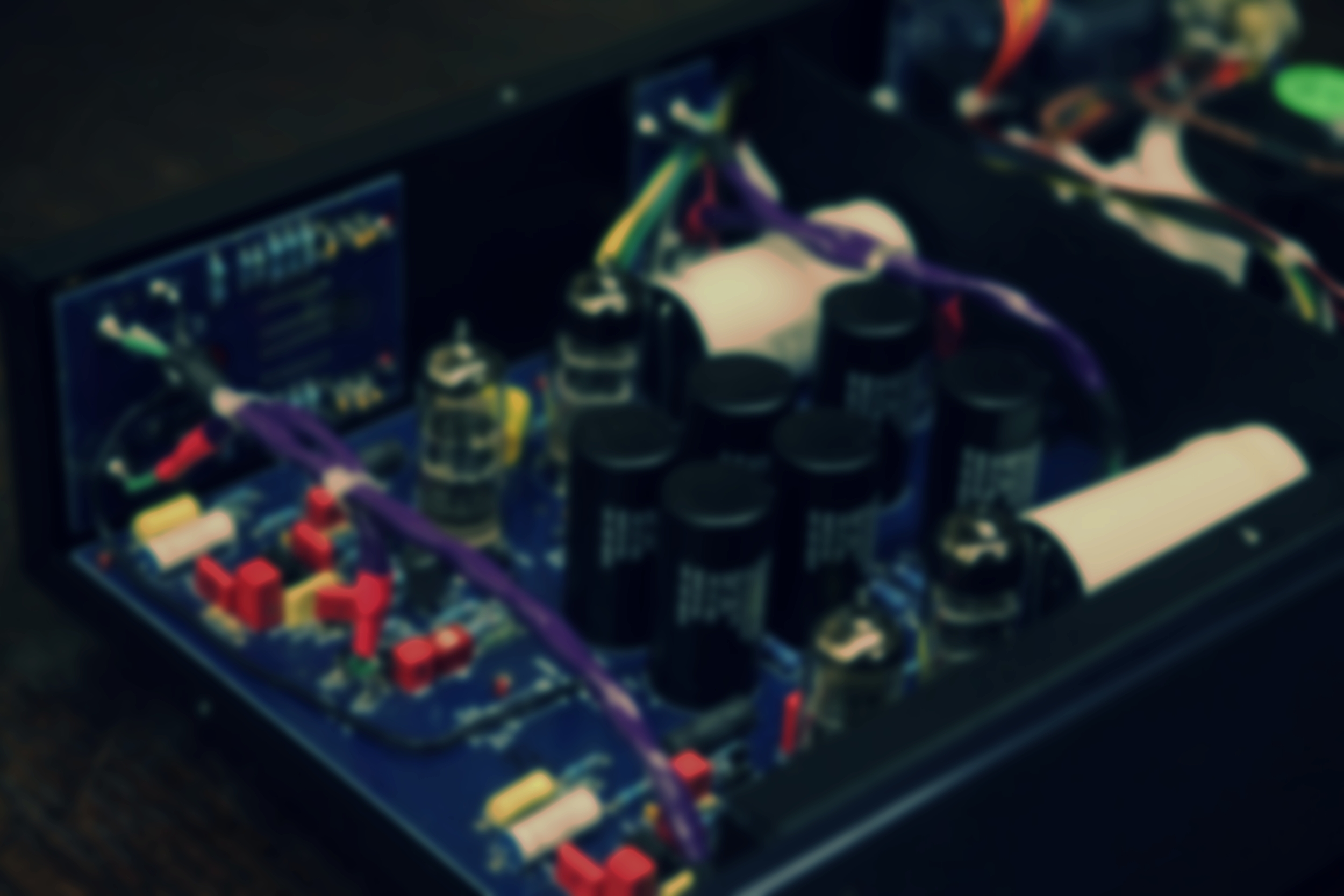
OWNER'S MANUAL
FREQUENTLY ASKED QUESTIONS
Q: How is the OASIS different from the CHINOOK?
The new chassis is deeper and has a solid steel top with big rounded radiused side edges which will be very much welcomed as a big fit 'n' finish improvement over the more primitive CHINOOK chassis.
Faceplate design features elegant inlaid "racetrack" in contrasting color to mother plate for visual interest. Facias available black n blue, or blue n black, or silver n black also.
The GAIN switches are relocated to the rear panel next to the loading switches for easier access.
Provision for user-installable CUSTOM cartridge loading.
The OASIS is powered by MANLEY POWER®, our new SMPS. It's a big sonic improvement.
Q: I want to use another external step-up transformer. Can I run it into my OASIS with the load set for 47 kOhms?
A: Sure thing! You can totally run an external MC step up transformer and run that into the OASIS input and set the load for 47 kOhms and set the GAIN to probably the lower setting.
Q: I have an XYZ Model Blah Blah cartridge. Where do I set the loads? Is it an MM or an MC cartridge? Where do I set the GAIN?
A: GAIN is GAIN. It doesn't care whether it is an MC or MM cartridge or an external step up transformer. Usually MM cartridges are going to be on the lower gain settings, like around 40dB of gain in a phono stage, and MCs on the higher gain settings, like around 60dB of gain.
Usually you'll see MM cartridges with a typical output of 1 milliVolt. MC cartridges maybe typically have about 0.5 milliVolts, for example. You'll have to see you much gain you need in your system and set the GAIN for as little as you can get away with. If you have cranked your preamplifier's Volume Control all the way up and you still can't play loud enough, then switch the GAIN up on your phono stage. What you don't want is MAX GAIN (and MAX NOISE) in your phono stage and then you line stage's Volume Control is barely cracked open at 9 o'clock.
LOADING also doesn't care where you set the gain. You can set the loading for any cartridge or external step up transformer wherever you want to. You will never harm anything or blow anything up. The loading resistor helps damp high frequency resonances of cartridges (and other inductors). Adding capacitance to low impedance cartridges will have no audible effect. Most MM cartridges are going to require a standard 47 kOhms resistive load setting with some capacitance added in parallel with the resistor. You would ultimately also want to add the cable capacitance in your calculations.
Read your Manley OASIS Owner’s Manual as there is lots of info about this topic in your manual…and watch this helpful TECH TIPS video! (Yes it is for the CHINOOK, and the same principles apply to the OASIS.)
Always refer to your cartridge manufacturer's website or owner's manual for the suggested load and then set your Manley phono stage to that load setting or as close to it as possible.
"DC Resistance" and "Internal Impedance" refer to the measurement of the winding inside the cartridge and that is NOT what the recommended load setting is.
If it is not clear on the cartridge maker's website or owner's manual what the Recommended Load for their cartridge is, please contact the cartridge manufacturer and have them clarify what the recommended load for their cartridge is. We are not going to know that! We would have to Google it just like you will. But we can provide lots of choices and flexibility to set the load close to what you need.
And again, being exactly on the number they suggest or being a few Ohms different is not going to make or break anything. All of these load settings have a very very subtle effect and they are difficult to even hear sometimes.
So relax, and listen, and enjoy your music!
Q: Which of the vacuum tubes are the input tubes?
A: The input tubes are located towards the back of the chassis in this unit. You can follow the wiring from the INPUT RCA jacks straight to the INPUT tubes. The output tubes are closest to the big giant white output capacitors and you can follow the OUTPUT cabling from those capacitors to the OUTPUT RCA jacks.
Q: I think that I want more gain.
The GAIN is adjusted by changing the resistors at the SOURCE of each FET in the first two gain stages. You can address these DIP switches on the rear panel of the unit and follow along the markings there. Generally speaking, most Moving-Magnet cartridges will use the 45dB or 50dB GAIN settings, and most Moving Coil pickups will prefer the higher 60dB and 65dB GAIN settings.
HOWEVER, it is always suggested to start with the lower GAIN choices of the two first make sure you don't really need that extra 5dB of GAIN. If your preamp's volume control is out of range and you cannot still get enough level out of your whole system, then you need more GAIN.
With more GAIN comes more NOISE so start with the stock settings before pre-judging that you need extra GAIN. Most folks do not need more GAIN and this is not like 720p vs 4K on a television where the bigger number is "better".
There is a more developed discussion of SYSTEM GAIN on the STEELHEAD web page so that you can more fully appreciate what we are saying here.
Q What are those LEDs inside the unit? I can see them when I look into the top cover.
A: We have some LEDs that will light up on the PCB to indicate the status of the GAIN selected. The LEDs are located towards the front left side of the main PCB and are labeled:
45dB Green LED
+15dB Red LED
+ 5dB Red LED
Remembering we start with 45dB of GAIN as standard and always active. The Green LED should always be lit.
On the rear panel of the chassis, pushing DIP switches DOWN on this OASIS unit engages the switch. The selected GAIN amount adds to the stock base 45dB level.
45dB = Both GAIN DIP switches UP = the green led (always on)
50dB = +15dB DIP Switch UP; +5dB DIP switch DOWN = green LED + the red LED indicating +5dB selection, because 45 + 5 = 50.
60dB = +15dB DIP Switch DOWN; +5dB DIP switch UP = green LED + the red LED indicating +15dB selection, because 45 + 15 = 60.
65dB = +15dB DIP Switch DOWN; +5dB DIP switch DOWN = green + the red LED indicating +15dB selection + the red LED indicating +5dB selection, because 45 + 5 + 15 = 65.
Q: I am looking at a bit of tube rolling on my Chinook phono stage. I am considering replacing the tubes with Voskhod 6N1P-EV (6Н1П-EB in Cyrillic script). These have the same specs as 6DJ8 except the filament is double at 600ma. Is it safe to replace the 6922 tubes with these tubes??
A: Yes, with this unit running from our MANLEY POWER® SMPS power supply, there should be ample current available in the heater rail to accommodate the Voskhod 6N1P-EB tubes.
Q: How do I reconfigure the mains voltage when I move to another country?
A: YOU DO NOT HAVE TO! The OASIS Phono Stage uses our fantastic modern MANLEY POWER switch mode power supply which operates all over the world at any voltage between 95VAC to 254VAC and at 50Hz or 60Hz.
Q: Can I update my Manley CHINOOK to an OASIS?
A: Nope. We cannot convert a CHINOOK to an OASIS. Sorry.
Q: How can I rackmount my Manley OASIS? The faceplate is not 19” and it doesn’t have rack holes.
A: Please use a rackmount shelf such as this depiction below:
Q: You mentioned above that you first listened to the prototype at Infrasonic Mastering. Why didn’t you name it “The Infrasonic Phono Stage”?
A: EveAnna Manley replies, “Well, ‘Infrasonic’. Yeah, that’s an unfortunate adjective for a phono stage, as we aren’t trying to amplify any frequencies that live beneath the sonic range, so we chose another long-time mastering studio partner to honor in naming this new product. OASIS Mastering was founded in the mid-1990’s by Eddy Schreyer. David Manley was hired to design and build Eddy’s first version of the OASIS Mastering facility on Ventura Boulevard in Studio City. Midway through the construction, David Manley left the country and moved to France leaving us to carry on and complete the installation. It was an emotionally charged time in my life, and these internal feelings fueled me to work hard and perform at a higher level. Eddy and fellow mastering engineer Gene Grimaldi were supportive friends to me at the time, and still are today. We all needed each other to move through those disruptive times, that’s for sure. Tying it back to the name of this phono stage, as this is a ‘set-it-and-forget-it’ design, after the loading and gain switches are set, you are invited to put aside your work and enjoy your musical vacation with our OASIS, a retreat for your vinyl enjoyment.”
Read more about OASIS Mastering here.
On Any Weekend…
Eddy Schreyer and EveAnna Manley putting on their rollerblades to skate down the beach path along the Pacific Coast Highway from Will Rogers State Beach through Santa Monica and Venice all the way to Manhattan Beach, and back, on any weekend during the late 1990's.


